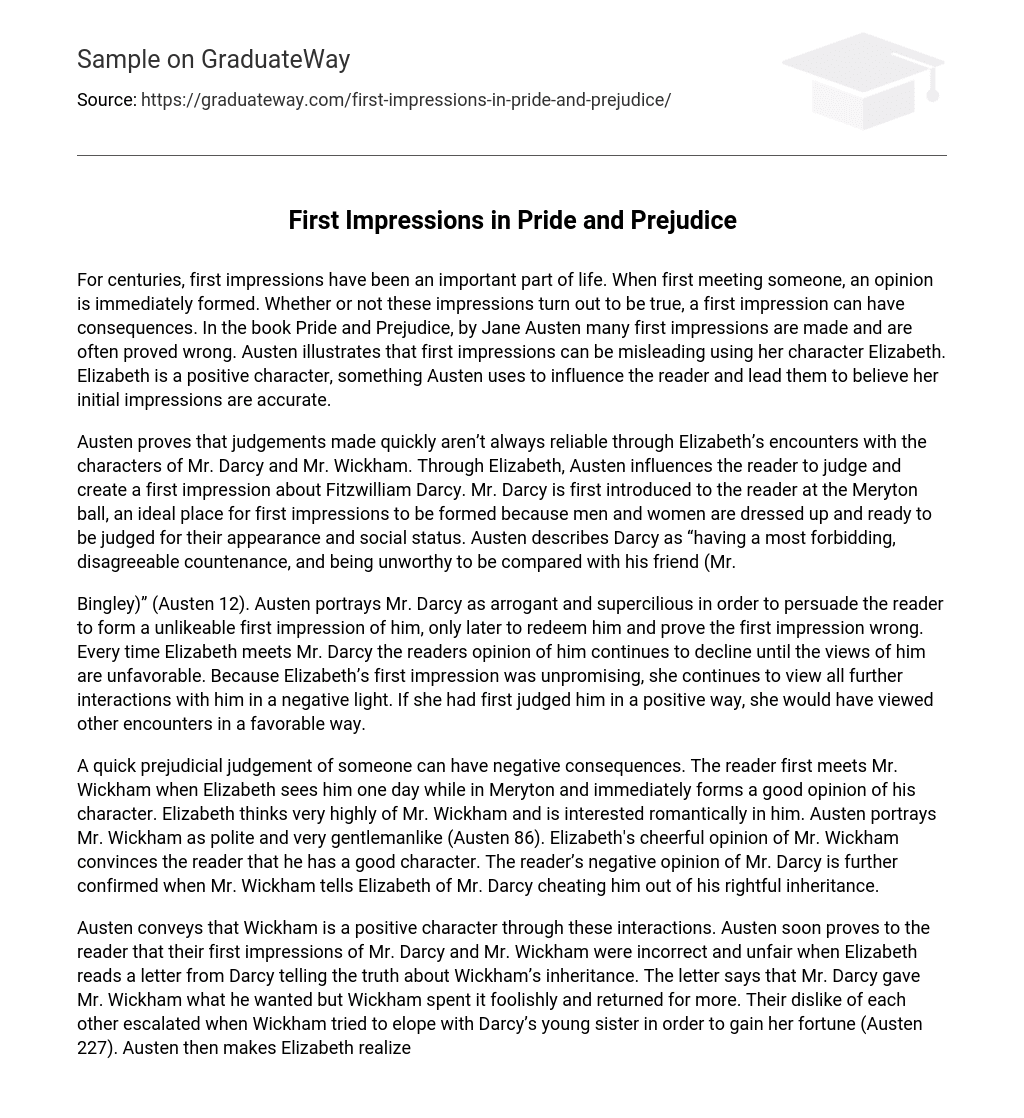Throughout history, the significance of first impressions has remained undeniable. Upon meeting someone for the first time, individuals form swift judgments that can potentially shape their interactions. Although these initial impressions may not always prove to be accurate, they can yield lasting consequences. Jane Austen’s novel Pride and Prejudice exemplifies this concept by showcasing numerous instances where first impressions are misleading. Austen effectively uses her character Elizabeth to convey this message, relying on her positive qualities to persuade readers into believing that her initial impressions are indeed trustworthy.
Austen demonstrates that making quick judgements is not always reliable by portraying Elizabeth’s interactions with Mr. Darcy and Mr. Wickham. Through Elizabeth, Austen guides the reader to form an initial opinion about Fitzwilliam Darcy. The reader is first introduced to Mr. Darcy at the Meryton ball, a setting ideal for making first impressions as people are dressed up and ready to be evaluated based on their appearance and social position. Austen describes Darcy as having a stern and unpleasant face, and being inferior to his friend (Mr. Bingley).
Bingley)” (Austen 12). Austen presents Mr. Darcy as proud and haughty to convince the reader to develop a dislikable initial perception of him, but later reveals his true character, proving the first impression to be incorrect. Every time Elizabeth encounters Mr. Darcy, her opinion of him deteriorates further until she views him unfavorably. Due to her initial unfavorable impression, she continues to perceive all subsequent interactions with him negatively. If she had initially formed a positive judgment of him, she would have seen other encounters in a favorable manner.
A hasty prejudiced judgment of someone can lead to negative consequences. When Elizabeth first sees Mr. Wickham in Meryton, she immediately forms a favorable impression of his character, considering him highly and even having romantic interest in him. Austen portrays Mr. Wickham as polite and gentlemanlike (Austen 86), which reinforces Elizabeth’s positive opinion of him. Moreover, when Mr. Wickham reveals to Elizabeth that Mr. Darcy has unjustly deprived him of his inheritance, it further solidifies the reader’s negative view of Mr. Darcy.
One way Austen showcases Wickham as a positive character is through her portrayal of his interactions. Additionally, Austen disproves the initial impressions readers may have had of Mr. Darcy and Mr. Wickham by having Elizabeth read Darcy’s letter, in which he reveals the truth about Wickham’s inheritance. According to the letter, Darcy gave Wickham what he desired, but Wickham wasted it and returned for more. The dislike between the two men escalated when Wickham attempted to elope with Darcy’s sister in order to gain her wealth (Austen 227). As a result of these revelations, Elizabeth realizes that her prior perceptions of both men were inaccurate.
The author of Pride and Prejudice by Jane Austen uses Elizabeth’s initial impressions of Wickham and Darcy to show that first impressions can be misleading. The author skillfully manipulates the reader into believing these initial impressions, only to later reveal the true personalities of the characters. Austen emphasizes that forming opinions about someone without thoroughly knowing their character and morals can be deceiving and that it is important to avoid a prejudice rush to judgement.





